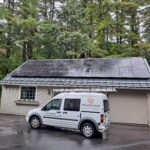Boston is one of 25 cities around the country designated as a Solar America City. Solar Boston, under Mayor Thomas Menino’s management, was a $550,000 initiative to increase the amount of solar energy in the city from 1/2 megawatt to 25 megawatts by 2015. The goal of the program is to take a broad, city-wide approach laying the foundation for a viable solar market and modeling that for other cities to follow.
Boston was selected as one of the thirteen original Solar America Cities on June 20, 2008. Currently, there are 25 major cities in the United States that are working to promote adoption of solar energy technologies to build a cleaner, more secure energy future. With a partnership through the Department of Energy, the Solar America Cities program has established relationships with over 180 organizations, including municipal, county, and state agencies, solar companies, universities, utilities, and non-profit organizations. These partners have pledged to cultivate a sustainable solar infrastructure that removes market barriers and advocates the adoption of solar energy by residents and businesses.
Through Solar Boston, the Boston will:
– Develop a strategy for the installation of solar technology throughout Boston , including mapping feasible locations, preparing a project-labor agreement, and planning the city-wide bulk purchase, financing, and installation of solar technology
– Work with local organizations to maximize Boston ‘s participation in state incentive programs and innovative financing initiatives
– Create a successor non-profit organization to implement the long-term goals of the partnership in cooperation with the Boston Energy Alliance
We are now approaching the start of the third year since Solar Boston was initiated. Let’s take a look at how the city measures how to their goal thus far. At this moment, there are 57 completed solar installations that generate a total of 1.9 megawatts. That’s a 280% increase in installed capacity from where they began at 1/2 megawatt, but it’s still a long way to the 25 megawatt goal by 2015. The good news is that there are 30 planned solar energy projects that will add an additional 2.2 megawatts capacity inching Boston to its goal.
The Solar Boston website provides an interactive guide tracking the progress of this initiative, showing you where the completed and planned solar energy systems are. The map is also a useful tool to show areas designated by the Boston Landmarks Commission where installations require review and areas designated by NSTAR where solar installations may be restricted. Any installation of a solar energy system to a property within the boundaries of a local historic district in Boston or to a property individually designated as a Boston Landmark may require review and approval by the historic district commission or the Boston Landmarks Commission. You may check in with the Boston Landmarks Commission at 617-635-3850 with the address of your property and your district to learn more about the additional aesthetic guidelines for your solar installation. If you’re in a restricted NSTAR region for solar, this means that solar electricity cannot be connected due to grid reliability. You should still check with NSTAR to determine whether or not your solar energy system will be able to interconnect with the electricity grid.








Your point of view caught my eye and was very interesting. Thanks. I have a question for you.
Can you be more specific about the content of your article? After reading it, I still have some doubts. Hope you can help me.
Thank you for your sharing. I am worried that I lack creative ideas. It is your article that makes me full of hope. Thank you. But, I have a question, can you help me?
Your point of view caught my eye and was very interesting. Thanks. I have a question for you. https://accounts.binance.com/en-IN/register?ref=UM6SMJM3
Your article helped me a lot, is there any more related content? Thanks!
Can you be more specific about the content of your article? After reading it, I still have some doubts. Hope you can help me.
Hello everyone, it’s my first visit at this site, and piece of writing is genuinely fruitful in support of me, keep up posting such
articles.
My page; nordvpn coupons inspiresensation (wall.sh)
I used to be able to find good info from your articles.
My website – nordvpn coupons inspiresensation
I don’t think the title of your article matches the content lol. Just kidding, mainly because I had some doubts after reading the article.
nordvpn special coupon code 2025 350fairfax
Pretty! This has been a really wonderful post. Thanks for providing this info.
Thank you for your sharing. I am worried that I lack creative ideas. It is your article that makes me full of hope. Thank you. But, I have a question, can you help me?